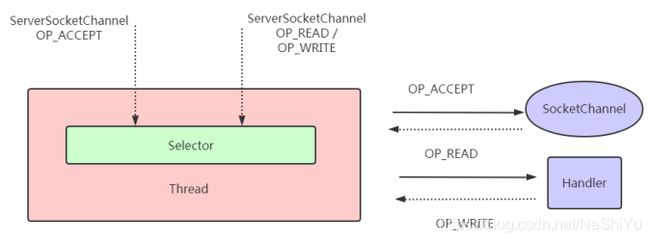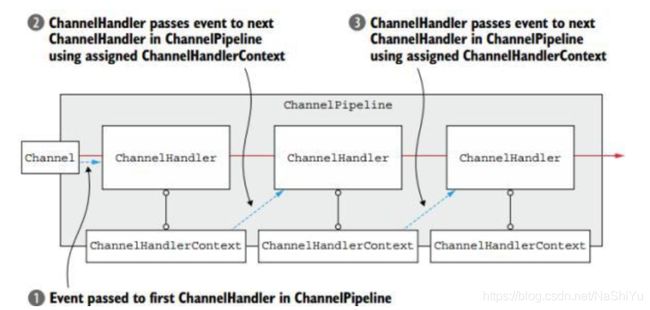Netty
目录
一、Netty 概述
二、线程模型
1. 单线程模型
2. 线程池模型
3. Netty模型
三、Netty核心组件
ChannelHandler 及其实现类
ChannelPipeline
ChannelHandlerContext
ChannelFuture
EventLoopGroup 和其实现类 NioEventLoopGroup
ServerBootstrap 和 Bootstrap
四、简单案例
一、Netty 概述
Netty 是由 JBOSS 提供一个异步的、 基于事件驱动的网络编程框架 , 简化和流程化了 NIO 的开发过程
- NIO 的类库和 API 繁杂,使用麻烦。你需要熟练掌握 Selector、ServerSocketChannel、SocketChannel、ByteBuffer 等.可靠性不强,开发工作量和难度都非常大
- NIO 的 Bug。例如 Epoll Bug,它会导致 Selector 空轮询,最终导致 CPU 100%
Netty优点
- 对各种传输协议提供统一的 API
- 高度可定制的线程模型——单线程、一个或多个线程池
- 更好的吞吐量,更低的等待延迟
- 更少的资源消耗
- 最小化不必要的内存拷贝
二、线程模型
1. 单线程模型
2. 线程池模型
3. Netty模型
- Netty 抽象出两组线程池, BossGroup 专门负责接收客户端连接, WorkerGroup 专门负责网络读写操作
- NioEventLoop 表示一个不断循环执行处理 任务的线程, 每个 NioEventLoop 都有一个 selector, 用于监听绑定在其上的 socket 网络通道。 NioEventLoop 内部采用串行化设计, 从消息的读取->解码->处理->编码->发送, 始终由 IO 线程 NioEventLoop 负责
三、Netty核心组件
ChannelHandler 及其实现类
ChannelHandler 接口定义了许多事件处理的方法, 我们可以通过重写这些方法去实现具 体的业务逻辑
我们经常需要自定义一个 Handler 类去继承 ChannelInboundHandlerAdapter, 然后通过 重写相应方法实现业务逻辑, 我们接下来看看一般都需要重写哪些方法
- - public void channelActive(ChannelHandlerContext ctx), 通道就绪事件
- - public void channelRead(ChannelHandlerContext ctx, Object msg), 通道读取数据事件
- - public void channelReadComplete(ChannelHandlerContext ctx) , 数据读取完毕事件
- - public void exceptionCaught(ChannelHandlerContext ctx, Throwable cause), 通道发生异常事件
ChannelPipeline
ChannelPipeline 是一个 Handler 的集合, 它负责处理和拦截 inbound 或者 outbound 的事 件和操作, 相当于一个贯穿 Netty 的链
- - ChannelPipeline addFirst(ChannelHandler... handlers), 把一个业务处理类(handler) 添加到链中的第一个位置
- - ChannelPipeline addLast(ChannelHandler... handlers), 把一个业务处理类(handler) 添加到链中的最后一个位置
ChannelHandlerContext
这 是 事 件 处 理 器 上 下 文 对 象 , Pipeline 链 中 的 实 际 处 理 节 点 。 每 个 处 理 节 点ChannelHandlerContext中 包 含 一 个 具 体 的 事 件 处 理 器 ChannelHandler , 同 时 ChannelHandlerContext 中也绑定了对应的 pipeline 和 Channel 的信息,方便对 ChannelHandler 进行调用。 常用方法如下所示
- - ChannelFuture close(), 关闭通道
- - ChannelOutboundInvoker flush(), 刷新
- - ChannelFuture writeAndFlush(Object msg) , 将 数 据 写 到 ChannelPipeline 中 当 前
- - ChannelHandler 的下一个 ChannelHandler 开始处理(出站)
ChannelFuture
表示 Channel 中异步 I/O 操作的结果, 在 Netty 中所有的 I/O 操作都是异步的, I/O 的调 用会直接返回, 调用者并不能立刻获得结果, 但是可以通过 ChannelFuture 来获取 I/O 操作 的处理状态。 常用方法如下所示
- Channel channel(), 返回当前正在进行 IO 操作的通道
- ChannelFuture sync(), 等待异步操作执行完毕
EventLoopGroup 和其实现类 NioEventLoopGroup
EventLoopGroup 是一组 EventLoop 的抽象, Netty 为了更好的利用多核 CPU 资源, 一般 会有多个 EventLoop 同时工作, 每个 EventLoop 维护着一个 Selector 实例。 EventLoopGroup 提供 next 接口, 可以从组里面按照一定规则获取其中一个 EventLoop 来处理任务。 在 Netty 服务器端编程中, 我们一般都需要提供两个 EventLoopGroup, 例如:
BossEventLoopGroup 和 WorkerEventLoopGroup
- - public NioEventLoopGroup(), 构造方法
- - public Future shutdownGracefully(), 断开连接, 关闭线程
ServerBootstrap 和 Bootstrap
ServerBootstrap 是 Netty 中的服务器端启动助手,通过它可以完成服务器端的各种配置; Bootstrap 是 Netty 中的客
户端启动助手, 通过它可以完成客户端的各种配置。 常用方法如下 所示
- - public ServerBootstrap group(EventLoopGroup parentGroup, EventLoopGroup childGroup),该方法用于服务器端, 用来设置两个 EventLoop
- - public B group(EventLoopGroup group) , 该方法用于客户端, 用来设置一个 EventLoop
- - public B channel(Class channelClass), 该方法用来设置一个服务器端的通道实现
- - public
B option(ChannelOption option, T value), 用来给 ServerChannel 添加配置 - - public
ServerBootstrap childOption(ChannelOption childOption, T value), 用来给接收到的通道添加配置 - - public ServerBootstrap childHandler(ChannelHandler childHandler), 该方法用来设置业务处理类(自定义的 handler)
- - public ChannelFuture bind(int inetPort) , 该方法用于服务器端, 用来设置占用的端口号
- - public ChannelFuture connect(String inetHost, int inetPort) 该方法用于客户端, 用来连接服务器端
四、简单案例
import io.netty.bootstrap.ServerBootstrap;
import io.netty.channel.*;
import io.netty.channel.nio.NioEventLoopGroup;
import io.netty.channel.socket.nio.NioServerSocketChannel;
import io.netty.channel.socket.nio.NioSocketChannel;
import io.netty.handler.codec.string.StringDecoder;
import io.netty.handler.codec.string.StringEncoder;
/**
* @description 接收客户端请求,打印在控制台
*/
public class NettyServer {
public static void main(String[] args) throws InterruptedException {
// 1. 创建2个线程池对象
NioEventLoopGroup bossGroup = new NioEventLoopGroup(); //负责接收用户连接
NioEventLoopGroup workGroup = new NioEventLoopGroup(); // 负责处理用户的IO读写
// 2. 创建启动引导类
ServerBootstrap serverBootstrap = new ServerBootstrap();
// 3. 设置启动引导类
// 添加到组中,2个线程组,第一个负责用户连接,第二个负责IO读写
serverBootstrap.group(bossGroup,workGroup)
// 设置通道 类型
.channel(NioServerSocketChannel.class)
// 绑定一个监听
.childHandler(new ChannelInitializer() {
// 当通道 被创建 时,执行此方法
@Override
protected void initChannel(NioSocketChannel nioSocketChannel) throws Exception {
// 一个通道 对应一个 pipeline, pipeline 贯穿整个netty, 里面有很多个 ChannelHandler(业务处理类)去执行
ChannelPipeline pipeline = nioSocketChannel.pipeline();
// 绑定编码
pipeline.addLast(new StringEncoder());
pipeline.addLast(new StringDecoder());
// 绑定业务逻辑 SimpleChannelInboundHandler 是一个 ChannelHandler
pipeline.addLast(new SimpleChannelInboundHandler() {
@Override
protected void channelRead0(ChannelHandlerContext channelHandlerContext, String s) throws Exception {
// 获取入栈信息,打印客户端 传递的数据
System.out.println(s);
}
});
}
});
// 4. 启动引导类绑定端口
ChannelFuture channelFuture = serverBootstrap.bind(9999).sync();
// 5. 关闭通道
channelFuture.channel().closeFuture();
}
} import io.netty.bootstrap.Bootstrap;
import io.netty.channel.Channel;
import io.netty.channel.ChannelInitializer;
import io.netty.channel.ChannelPipeline;
import io.netty.channel.nio.NioEventLoopGroup;
import io.netty.channel.socket.nio.NioSocketChannel;
import io.netty.handler.codec.string.StringEncoder;
/**
* @description 客户端给服务端发送数据
*/
public class NettyClient {
public static void main(String[] args) throws InterruptedException {
// 1. 创建 连接池对象
NioEventLoopGroup group = new NioEventLoopGroup();
// 2. 创建客户端 的启动引导类 BootStrap
Bootstrap bootstrap = new Bootstrap();
// 3. 配置启动引导类
bootstrap.group(group)
// 设置通道为NIO
.channel(NioSocketChannel.class)
// 设置channel 初始化监听
.handler(new ChannelInitializer() {
// 当channel初始化时,会执行
@Override
protected void initChannel(Channel channel) throws Exception {
ChannelPipeline pipeline = channel.pipeline();
// 设置编码
pipeline.addLast(new StringEncoder());
}
});
// 4. 使用启动引导类连接服务器,获取一个channel
Channel channel = bootstrap.connect("127.0.0.1", 9999).channel();
// 5. 循环写数据给服务器
while (true){
// 给服务器写数据
channel.writeAndFlush("helo server, this is client...");
Thread.sleep(2000L);
}
}
}




